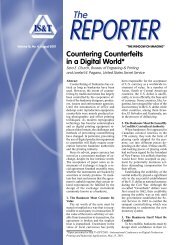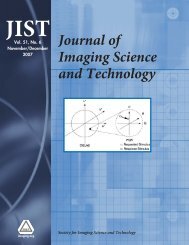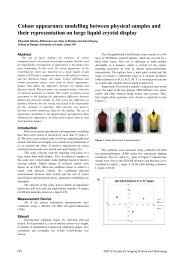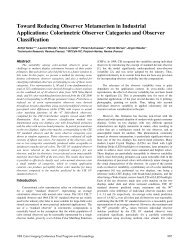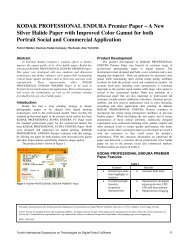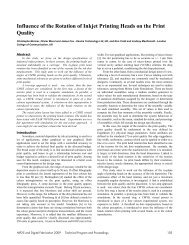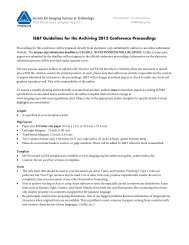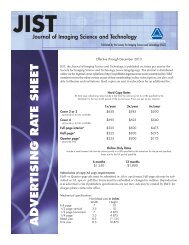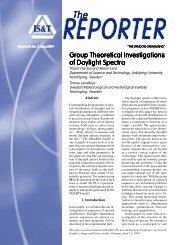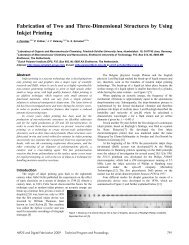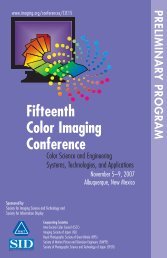JIST - Society for Imaging Science and Technology
JIST - Society for Imaging Science and Technology
JIST - Society for Imaging Science and Technology
Create successful ePaper yourself
Turn your PDF publications into a flip-book with our unique Google optimized e-Paper software.
Kajondecha, Cheng, <strong>and</strong> Hoshino: Human perception of contour in halftoned density step image<br />
Figure 5. Perception ratio of average patterns diagonal <strong>and</strong> perpendicular pattern vs density differences<br />
192-180 at four distances <strong>and</strong> a dot cycle of 1–4 mm when the halftone angle is 45°. The plates show the<br />
conditions where the observation distance is a 0.5 m, b 1m,c 2m,<strong>and</strong>d 3m.<br />
halftone frequencies of 1mm, 2mm, 3mm, <strong>and</strong> 4mm.In<br />
a digital system, the halftone screen angle is simulated by<br />
placement of the dots within the halftone cells. Figure 7(a)<br />
shows a comparison between a screen angle of 0° <strong>and</strong> 45° at<br />
an observation distance of 0.5 m relativetoaveragevalueof<br />
diagonal <strong>and</strong> perpendicular pattern under an illumination of<br />
1.010 3 Lux. The result shows that at a halftone cycle<br />
1mm, the halftone image with the screen angle 45° can be<br />
detected more easily than the halftone image with the screen<br />
angle 0°.<br />
According to the results shown in Fig. 7, the perception<br />
ratio of the halftone image with a screen angle of 45° is<br />
higher than that with a screen angle of 0° at a halftone cycle<br />
of 1mm. The sensitivity of our human visual system is reported<br />
to decrease at angles of 45° <strong>and</strong> 135°. 6 There<strong>for</strong>e, the<br />
stimuli of the halftone dot when the halftone angle is 45°<br />
decreases, <strong>and</strong> we perceive the contour more easily when the<br />
angle is 0°. However,atcyclesof2mm, 3mm, <strong>and</strong> 4mm,<br />
the ratios do not show as clear a difference as when the dot<br />
cycle is 1mm, possibly because the dot stimulus is too<br />
strong. There<strong>for</strong>e, in some cases, the opposite relationship<br />
can arise <strong>for</strong> all of the other cycles (2 mm, 3mm, <strong>and</strong><br />
4mm).<br />
Effect of Illumination<br />
One factor that affects contour perception of a halftoned<br />
image is illumination. Figure 8 shows the perception ratio<br />
dependence on density difference at a halftone angle of 45°.<br />
The results show a comparison of when the illumination<br />
conditions are 1.010, 1.010 2 , <strong>and</strong> 1.010 3 Lux <strong>and</strong> observation<br />
distance is 1m<strong>and</strong> 3m, under halftone cycles of<br />
1mm<strong>and</strong> 4mm, respectively. Figure 8(c) shows that the<br />
perception ratio increases with illumination when the dot<br />
cycle is 1mmat an observation distance of 3m. Figures<br />
8(b) <strong>and</strong> 8(d) show that the perception ratio decreases when<br />
the dot cycle is 4mmat observation distances 1m<strong>and</strong> 3m<br />
with increasing illumination. In summary, the perception<br />
404 J. <strong>Imaging</strong> Sci. Technol. 515/Sep.-Oct. 2007




